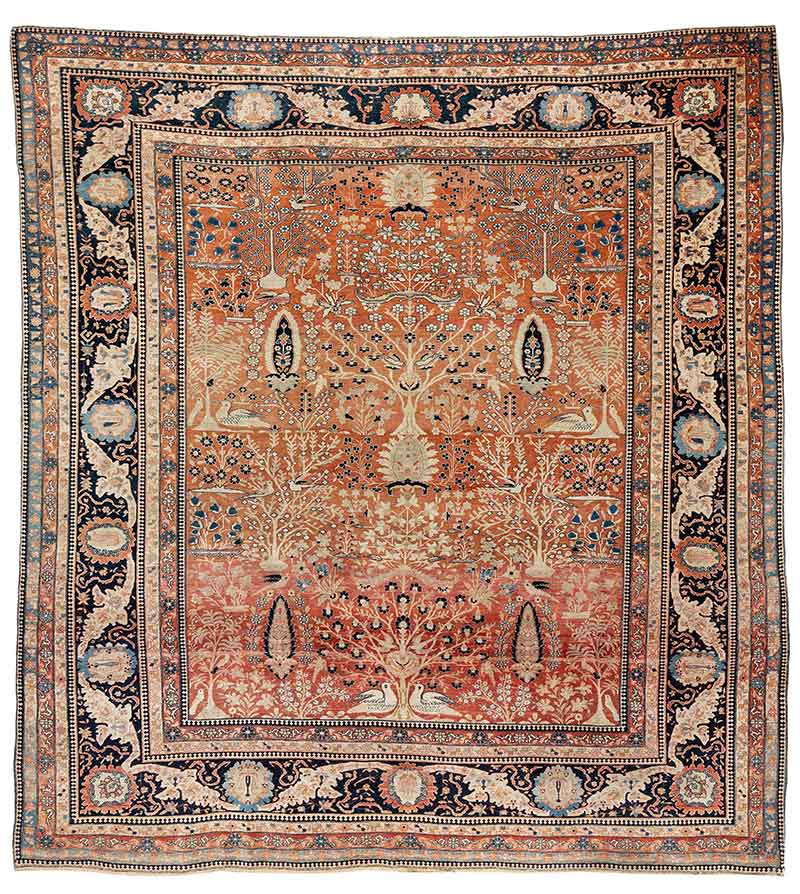The specialist's choice – Christopher Stålhandske lists carpet favourites
Specialists choice Christopher Stålhandske
We have spoken with Christopher Stålhandske, Head Specialist Carpets, textiles and Islamic works of art, who talks about the selection at Important Winter Sale. He also takes the opportunity to list some of his favourite objects among the substantial amount of high-quality carpets at this fall's auction.
What can we look forward to in this Important Winter Sale?
– This year's selection is by far the best we have had in many years and shows the diversity we have in carpets, textiles and Islamic work of art. We have carpets, which could very well be among the collections of some of the world's most distinguished museums. We also have a large collection of antique and modern carpets and textiles from Sweden.
Feel free to look through our web catalogue, and we welcome you to stop by for a viewing. Don't hesitate to email if you have any questions. Welcome!
Viewing December 1 - 6th, Berzelii Park 1, Stockholm.
Open Mon–Fri 11 AM - 18 PM, Sat–Sun 11 AM–16 PM.
Auction December 7–9
Explore the catalogue
Explore the carpet department

A carriage cushion last quarter of the 18th century
This is exactly what the title reveals! A cushion that is used when traveling by horse and carriage. The pattern, "Tree and hourglass", from the late 18th century is relatively rare. These patterns were mainly made in Skytts or Oxie district in Scania. Today, carrige cushions are used in the same way as tapestries and is mostly mounted on the wall.
The rug will be sold during Important Winter Sale, December 7
Estimate: 18 000 - 20 000 SEK
To the carpet

Koum Kapi' rug Ottoman empire
The Istanbul carpets that came to be known as "Koum Kapi" were woven by Armenian weavers, most of whom were based in that district, better known today for fishing. After the efforts of two Armenians, Zara Agha and Apraham Agha in the late 19th century, the first weaving chairs were set up for what would become the 'Koum Kapi' school in Istanbul. The technical ability of their weavers and the fine quality of their materials, mainly silk and metallic thread, resulted in a long tradition of excellence.
The rug will be sold during Important Winter Sale, December 7
Estimate: 50 000 - 60 000 SEK
To the carpet

'Motachem' carpet Kashan
This carpet is from a man named Motaschem, who in the late 19th century moved from his hometown of Feraghan to the great carpet district of Kashan. He brought with him the patterns common to Feraghan but knotted rugs in the same way as in the new home of Kashan. He signed very few carpets but always had a violet silk seam, at both sides, as a hallmark and these are still present at this carpet.
The rug will be sold during Important Winter Sale, December 7
Estimate: 60 000 - 80 000 SEK
To the carpet

North east Safavid persian "Blossom and sickle" carpet, Safavid dynasty
The Safavids were in power in Persia from 1501 to 1736. Shah Abbas the Great moved the capital from Qazvin to Isfahan in 1598, and a new Persian golden age began. New mosques, universities and bathhouses were built there. Testimonials indicate that Isfahan was one of the most beautiful cities in the world. The art of tying carpets defined the culture, and it was considered one of the noblest things. During this time, the export of Persian rugs to Europe increased.
The shapes of these carpets are often long and narrow, just like the example in the auction. With time, the patterns became more open, and the name "Sickle-leaf" comes from the large swinging leaf tendrils. The most famous "Sickle-Leaf" patterned rug is from the collection of William Andrews Clark (1839–1925). The rug was part of a larger art collection and was sold in New York in 2013. The rug sold for $33 million and is, to this day, the most expensive rug ever sold at auction.
The rug will be sold during Important Winter Sale December 7
Estimate: 60 000 - 80 000 SEK
To the carpet

West Anatolian "Lotto" Carpet, 17th century
”Lotto”carpets derive their name from the Renaissance painter Lorenzo Lotto, (c. 1480 – 1556). Lotto depicted an example in ‘The Alms of St. Anthony’, 1542, Venice, although they also appear in other and earlier works such as Sebastiano del Piombo's ‘Cardinal Bandinello Sauli’, of 1516. This indicates that the earliest examples are at least from the very early 16th century. The pattern continued to be popular until the late 18th century.
The cloudband border design in this rug can be seen in paintings from as early as 1611. The majority being illustrated during the period 1660-70 (O.Ydema, Carpets and their Datings in Netherlandish Painting 1540-1700, Zutphen, 1991, p.36, diag.8.) These indicate that this rug could date from as early as the first quarter of the 17th century.
The carpet will be sold at the Important Winter Sale December 7th
Estimate: 60 000 - 80 000 SEK
To the "Lotto" carpet

**Bidjar Garus Matta''
The Garus pattern appears mainly among Bidjar rugs. It consists of a garden pattern and is characterized by its extensive rolling, split arabesques. This pattern is usually associated with carpets from 16th and 17th century Iran, but the design is still used to this day. The most famous rug with this Garus pattern is the so-called Costikyan-McMullan rug in the Metropolitan's collections. The middle field of the Costikyan-McMullan rug is identical to the auction's carpet, and the size is also similar. The Costikyan-McMullan carpet is dated 1209 AD. / 1794, indicating that these patterns also occurred during the Persian Golden Age, the Safavid dynasty.
The rug will be sold during Important Winter Sale, December 7
Estimate: 25 000 - 30 000 SEK
To the carpet

Lisätietoa & kuntoraportteja Ota yhteyttä asiantuntijaamme

Tukholma
Christopher Stålhandske
Asiantuntija matot, tekstiilit, islamilainen taidekäsityö
+46 (0)708 19 12 58

Tukholma
Björn Extergren
Johtava asiantuntija sisäänjättö ja myynti. Asiantuntija antiikkikalusteet, taidekäsityö ja aasialainen keramiikka
+46 (0)706 40 28 61





























